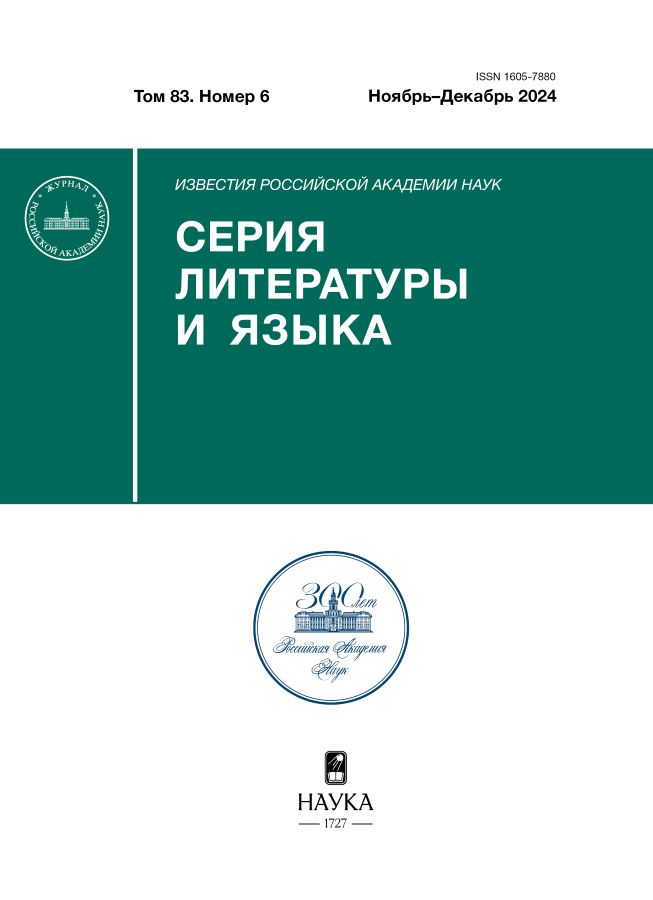Choosing a Path Through the Text: Problematization of the Paratext in P. Austerʼs Novel “The Night of the Oracle” (2003)
- Авторлар: Shulyatyeva D.V.1
-
Мекемелер:
- Higher School of Economics
- Шығарылым: Том 83, № 6 (2024)
- Беттер: 108-117
- Бөлім: Articles
- URL: https://rjonco.com/1605-7880/article/view/657002
- DOI: https://doi.org/10.31857/S1605788024060094
- ID: 657002
Дәйексөз келтіру
Аннотация
In this article the author examines the reception of J.-L. Borgesʼ concept of “forking paths” in P. Austerʼs contemporary novel “The Night of the Oracle”. The “forking paths” become the main principle by which the readerʼs interaction with the text is modeled in the novel. “Night of the Oracle” problematizes linear reading which is more familiar to the reader and includes elements that stimulate the reader to move through the text non-linearly, disrupting the usual course. Such elements in the novel are footnotes included in its paratext. The paratext in the novel is problematized: it not only switches the readerʼs attention from the main text to its “threshold” (in terms of G. Genette), not only stimulates him to move forward, then back, not only puts an emphasis on choice as a kind of experience offered to the reader. The paratext (in the form of footnotes) turns out to be included in the diegetic world of the novel, it now creates those forks, those “forking paths” along which the reader is invited to walk, discovering variations of the events already presented in the novel. However, the functions of footnotes in the novel are not limited to this: they either vary the events of the novel, or, on the contrary, “throw” the reader out of the diegetic world, preventing him from immersing (in M.L. Ryanʼs terms) in the events presented in the narrative. Footnotes, in addition, include comments on the events already described, are designed to expand the context of what is happening in the novel, are (in some cases) an “optional” addition that is offered to the reader to vary his own “path through the text”. Due to this involvement of paratextual elements in the novel, the reader is always in the process of choosing, in captivity of variations that cover both his own movement through the text, but also the events taking place directly in the novel. The experimental use of paratext in a novel thus problematizes the readerʼs experience, making it more heterogeneous, but also complicates the representation of narrative events.
Негізгі сөздер
Толық мәтін
Авторлар туралы
D. Shulyatyeva
Higher School of Economics
Хат алмасуға жауапты Автор.
Email: dshulyatyeva@hse.ru
Cand. Sci. (Philol.), Associate Professor
Ресей, MoscowӘдебиет тізімі
- Alvarez, M. Paul Austerʼs Ghosts. The Echoes of European and American Tradition. Lexington Books, 2018.
- Diffrient, D. Alternate Futures, Contradictory Pasts: Forking Paths and Cubist Narratives in Contemporary Film. Screening the Past, 2006.
- Ensslin, A., Bell, A. Digital Fiction and the Unnatural: Transmedial Narrative Theory, Method, and Analysis. Columbus: Ohio State University Press, 2021.
- Bökös, B. Palimpsestuous Intermediality: Paul Austerʼs “City of Glass” (1985) and “City of Glass: The Graphic Novel” (1994). Hungarian Journal of English and American Studies (HJEAS). 2014, No. 20 (2), pp. 101–119.
- Dubin, B.V. Literaturnye okrainy i tajnopis celogo [Literary Outskirts and the Secret Writing of the Whole]. Borges, H.L. Stihotvoreniya. Novelly. Esse [Poems. Short Stories. Essay]. Moscow: AST Publ., 2003, pp. 5–37. (In Russ.)
- Prince, G. The Disnarrated. Style, 1988, Vol. 22, pp. 1–8.
- Panova, O.Y. Postmodernizm. SShA [Postmodernism. USA]. Slovar techenij literatury XX veka. Rossiya, Evropa, Amerika. Vdvuh knigah. Kniga vtoraya: P–YA. Ukazateli. Otv. red. A.F. Kofman; redkollegiya: E.D. Galcova, Yu.N. Girin, V.B. Zuseva-Ozkan, T.V. Kudryavceva, O.Yu. Panova, O.I. Polovinkina, I.A. Ebanoidze [Dictionary of Literary Trends of the 20th Century. Russia, Europe, America. In Two Books. Book Two: P–Ya. Indexes. Ed. by A.F. Kofman; editorial board: E.D. Galtsova, Yu.N. Girin, V.B. Zuseva-Ozkan, T.V. Kudryavtseva, O.Yu. Panova, O.I. Polovinkina, I.A. Ebanoidze]. Moscow: IMLI RAS, “River of Times” Publ., 2023. pp. 80–84. (In Russ.)
- Ilyin, I.P. Postmodernizm ot istokov do konca stoletiya: evolyuciya nauchnogo mifa [Postmodernism from the Origins to the End of the Century: The Evolution of Scientific Myth]. Moscow: Intrada Publ., 1998. (In Russ.)
- Genette, G. Introduction to the Paratext. New Literary History, 22 (2). 1991, pp. 261–272.
- Ilyin, I.P. Postmodernizm. Slovar terminov [Postmodernism. Dictionary of Terms]. Moscow: INION RAS – Intrada Publ., 2001. (In Russ.)
- Zenkin, S.N. Teoriya literatury: problemy i rezultaty [Theory of Literature: Problems and Results]. Moscow: New Literary Review Publ., 2018. (In Russ.)
- Bernstein, S. The Question Is the Story Itself: Postmodernism and Intertextuality in Austerʼs New York Trilogy. P. Merivale & S. E. Sweeney (Eds.), Detecting Texts: The Metaphysical Detective Story from Poe to Postmodernism. University of Pennsylvania Press, 1999, pp. 134–154.
- Sternberg, M. Universals of Narrative and Their Cognitivist Fortunes (II). Poetics Today, Vol. 24, No. 3, 2003, pp. 517–638.
- Genette, G. Figury: Raboty po poetike: V 2 t. [Figures: Works on Poetics: In 2 Volumes]. Moscow, 1998. (In Russ.)
Қосымша файлдар









